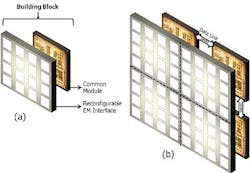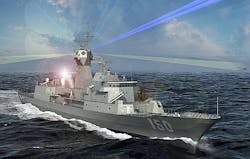DARPA seeks to speed RF and microwave array development for radar, comms, and SIGINT
ARLINGTON, Va., 16 May 2013. U.S. military researchers are asking industry to find new ways of shortening the time it takes to develop, deploy, and upgrade RF and microwave arrays for communications, signals intelligence (SIGINT), radar, and electronic warfare.
The U.S. Defense Advanced Research Projects Agency (DARPA) in Arlington, Va., have released a solicitation (DARPA-BAA-13-26) for the Arrays at Commercial Timescales (ACT) program, which seeks to move beyond the traditional specialized and time-consuming array design process and focus on new ways of developing electromagnetic arrays.
The DARPA ACT program focuses on three technology areas. The first seeks to realize a common hardware module that can be applied broadly to many disparate array functions. The second seeks to develop a reconfigurable electromagnetic interface for different polarizations, frequencies, and bandwidths.
The third area, meanwhile, seeks to demonstrate a scalable infrastructure to combine arrays on physically disconnected platforms into a larger aperture with precise timing and localization data. The idea is to create electromagnetic interface arrays that can be fielded at a rate to match that of commercially developed electronic components.
Today’s RF and microwave systems increasingly use antenna arrays for multiple beam forming and electronic steering, yet these arrays are expensive and time-consuming to develop and upgrade in the field. While the commercial market has set the pace of how electronic systems evolve, military electronics development lags behind, DARPA researchers say.
A fielded military system based on decade-old electronics, for example, has a small fraction of the capabilities of a system based on modern components, and the performance gap is widening between RF components and digital electronics.
As a result, a system with static RF or analog features cannot capitalize on advancements of the underlying digital electronics. It is imperative, therefore, to define a path toward shorter design cycles and infield updates, DARPA researchers say.
Research must push past the traditional barriers that lead to 10-year array development cycles, 20-to-30-year static life cycles, and costly service life extension programs. The DARPA ACT program will respond to these conditions by developing new technology for custom arrays that takes advantage of constantly evolving digital components.
Specifically, the program seeks to develop a separable building block in which as much as 70 80 percent of an array’s development cycle cost is built in to a common module that will encompass functionality common across many applications.
The common module will focus on translating RF or IF inputs to digital beams with sufficient processing to create a manageable data flow among sub-arrays.
ACT building blocks will scale not only to form larger arrays, but also that can scale across platforms to generate coherent, spatially distributed radiation.
DARPA has identified three challenges: the long development times for array systems often with limited design re-use; the fixed design choices that lock-in electromagnetic parameters once the system is fielded; and practical limitations on fielding high-power arrays.
The common module portion focuses on creating digitally influenced phased array panels with a common module, which will divide a large array into smaller building blocks. Reconfigurable electromagnetic interface focuses on creating a customizable electromagnetic interface to the common module.
Over-the-air coherent transmitter aggregation, meanwhile, focuses on demonstrating the technologies to show that physically separated phased arrays can combine power through precise timing and localization information distributed over a wireless network.
Companies interested should respond no later than 17 June 2013. For questions or concerns email DARPA's William Chappel at [email protected].
More information is online at https://www.fbo.gov/spg/ODA/DARPA/CMO/DARPA-BAA-13-26/listing.html.

